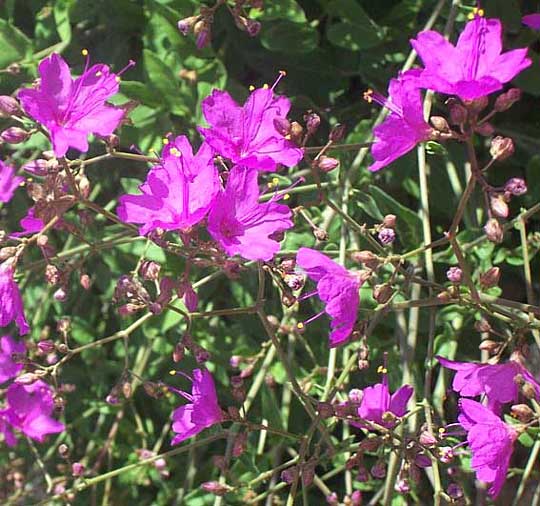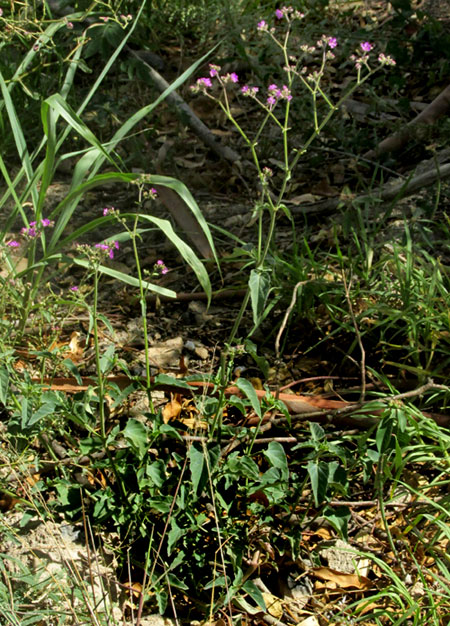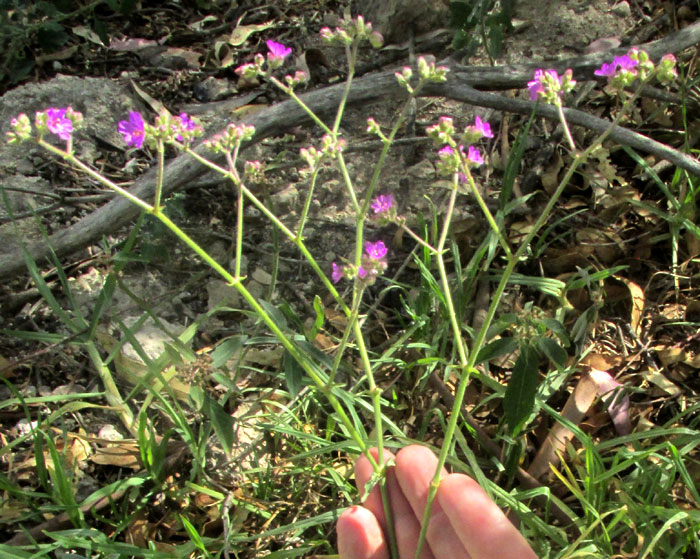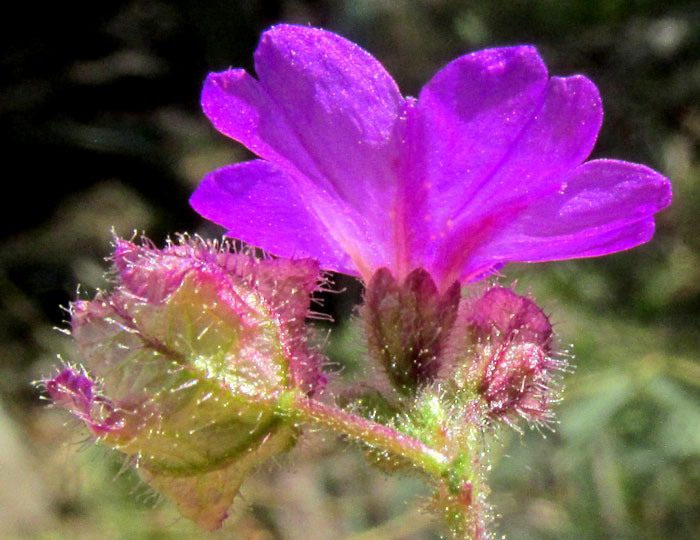Excerpts from Jim Conrad's
Naturalist Newsletter
from the September 21, 2007 Newsletter issued from Sierra Gorda Biosphere Reserve, QUERÉTARO, MÉXICO
"LITTLE MARVELS" FOUR O'CLOCKS
I arrived in the semi-desert too late in the rainy season to "see the desert in bloom." Especially the many cacti bore brown, desiccated corollas or no corollas at all atop swelling ovaries slowly maturing into fruits.
Still, one wildflower species was absolutely stunning, especially in the morning's brilliant sunlight. You can see a particularly handsome colony spectacularly abloom on a talus slope below a roadcut below:

I'm pretty sure this is a member of the genus Mirabilis, but I'm not sure which species {identified below}. Mirabilis is the Four-O'Clock genus. You can see how similar the flower structure is to your own garden Four-O'Clocks below:

Mexicans call members of this genus Maravillas or Maravillitas, which means "Marvels," or "Little Marvels." It's a decent name because you do want to just sit and marvel at how sunlight glows in the flowers. Even the Latin Mirabilis means "wonderful."
entry dated August 2, 2022, issued from near Tequisquiapan, elevation about 1,900m (6200 ft), ~N20.57°, ~ W99.89°, Querétaro state, MÉXICO
MARAVILLAS, A CLOSER LOOK
In 2007 when the above was written I didn't have a camera for close-ups and the Flora del Bajío treating the plants of this region wasn't online, to help determine which of the 11 or so Mirabilis species found in our region this one might be. Now in 2022 we can know, and admire this pretty plant more closely.

Here I don't find Maravillas growing in such spectacular colonies as seen atop this page. Ours are more weedy, like the one seen above at the edge of a cornfield. The cornfield is on deep alluvial valley soil, and the above plant grows taller than the ones seen in 2007.

The inflorescence is large and diffuse, small clusters of flowers opening at the tips of the outermost of repeatedly branched stems.

None of the 300 or so species in the Four-O'Clock Family, the Nyctaginaceae, produce flowers possessing a corolla. But the flowers of many species, like what's shown above, produce large, colorful calyxes which look like corollas. Textbook calyxes are thought of as small, green, cup-shaped structures occurring below the much larger, colorful corollas. This feature of not having real corollas is an important field mark for the Four-O'Clock Family. The above flower also displays the unusual combination of having five calyx lobes but only three stamens. The stamens consist of yellow anthers atop purple filaments. The flower's slender, purple style elevates its purple stigma well above the stamens, making the pollen-receptive stigma the first part of the flower touched by approaching pollinators. Note the extremely large pollen grains adhering both to the anthers and adjacent sepal lobes.

From the side, our flower looks even more as if it has a regular corolla subtended by a regular calyx. However, what appears to be a typical calyx with five sepals is an "involucre" consisting of modified leaves, or bracts, fused into a calyx-like structure. In this species it's a very hairy involucre, with long, soft hairs tipped with sticky glands that can dissuade caterpillars and such from climbing the stem to eat the flowers.
Admittedly, so far this flower's involucre does look like a calyx. However, once the flower is pollinated, the corolla-like calyx falls off, and the ovary begins growing toward becoming a fruit, and then finally the leafy nature of the bracts forming the involucre becomes apparent:

Notice the modified leaves' green midribs and secondary veins. Calyx sepals wouldn't have that. Also, note that the warty ovary bears a pit-like scar atop it, where the corolla-like calyx fell off. This means that the ovary is "inferior," for in flowers with inferior ovaries, both calyx and corolla arise atop the ovary. Therefore the structure below the above ovary can't be a calyx and has to be an involucre formed of modified leaves.
The warts, or tubercles, on the ovary will develop into structures on the mature fruit that produce mucilage when wet. I can't find an explanation of this interesting feature. However, James Willson and Richard Spellenberg in their 1977 study entitled "Observations on Anthocarp Anatomy in the Subtribe Mirabilinae (Nyctaginaceae)" describe the fruit as a special kind of accessory fruit. The authors say that the function of the mucilage-producing tubercles isn't known, but may be "involved with epizoochory and may be associated with germination." Epizoochory is seed dispersal by transporting on the outside of animals.

Above, the leaves occur opposite one another on the stem, the condition of the vast majority of the Four-O'Clock Family, and they're similar enough to leaves on the commonly planted garden Four-O'Clock. All the vegetative parts are covered with short, soft hairs.
All the above details and more lead us to MIRABILIS VISCOSA, in some publications given the English name Viscid Four-O'Clock, which is the translation of the binomial. The species occurs in tropical deciduous and arid scrub, especially in disturbed zones, and in weedy areas such as our cornfield edge. It's distributed from northern Mexico south to Oaxaca, appears to be absent in Central America, but occurs in western South America. Also, the gardening world has developed ornamental cultivars from it such as 'Exotic Dreams,' described as fast-growing and producing blue to green leaves and spikes of bright purple flowers from summer until autumn.
A closely related and much planted species, Mirabilis jalapa, is famous for producing compounds that are medicinal in certain precise dosages, but toxic and psychedelic in others. Certain web pages warn that the black seeds and roots are extremely toxic if ingested by dogs or cats. Hardly any information can be found about our Viscid Four O'Clock, though, other than its use in gardens.